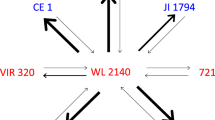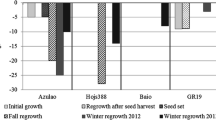Summary
Recurrent or introgressive backcrossing of Phaseolus vulgaris — P. acutifolius hybrids with either P. vulgaris or P. acutifolius increased fertility, as measured by pollen stainability and seed per pod from non-manipulated flowers, while invariably resulting in loss of traits from the non-recurrent parent. When hybrids were backcrossed with each of the parent species in alternate generations (congruity backcrossing), fertility decreased in early generations but gradually increased in later generations. By the fourth or fifth generation, congruity-backcross hybrids produced numbers of seeds per pod from non-manipulated flowers comparable to those of parent species, although the percent of stainable pollen tended to be lower. Congruity-backcross hybrids were intermediate to parent species when pedigrees contained equal representation of parents but favored the majority parent when pedigrees were unbalanced. Individuals exhibiting symptoms of developmental incongruity, such as abnormal leaflet number, foliar variagation, or unusual growth patterns, occurred in each generation. However, completely new characteristics appeared after the second backcross generation, presumably due to recombination. Backcrossing to both parent species in alternate generation reversed incongruity, allowing selection for fertility without loss of traits from one of the parent species.
Similar content being viewed by others
References
Allard RW (1960) Principles of plant breeding. Wiley, New York
Anderson E (1949) Introgressive hybridization. Hafner, New York
Andersen E (1954) Introgression in Adenostoma. Ann Miss Bot Gard 41:339–350
Buishand TJ (1956) The crossing of bean (Phaseolus spp.). Euphytica 5:41–50
Clayton E (1950) Sterile tobacco. J Hered 41:171–175
Dudley JW (1982) Theory for transfer of alleles. Crop Sci 22:631–637
Gottschalk W (1985) Phytotron experiments Pisum. I. Influence of temperature on the flowering behaviour of different genotypes. Theor Appl Genet 70:207–212
Haghighi K (1986) Methods of hybridization of two bean species: Phaseolus vulgaris and P. acutifolius. PhD thesis, University of Minnesota, St Paul
Haghighi K, Ascher PD (1988) Interspecific hybridization of Phaseolus vulgaris with cultivated and wild accessions of P. acutifolius. 3 Am Soc Hortic Sci (in press)
Hanson WD (1959) The breakup of initial linkage blocks under selected mating systems. Genetics 44:857–868
Harlan JR (1966) Plant introduction and biosystematics. In: Frey KJ (ed) Plant breeding. Iowa State University Press, Ames, pp 55–83
Hogenboom NG (1973) A model for incongruity in intimate partner relationships. Euphytica 22:219–233
Hogenboom NG (1975) Incompatibility and incongruity: two different mechanisms for the non-functioning of intimate partner relationships. Proc R Soc London Ser B 188:361–375
Hogenboom NG (1984) Incongruity: non-functioning of intercellular and intracellular partner relationships through nonmatching information. In: Lins-kens HF, Heslop-Harrison J (eds) Cellular interactions. (Encyclopedia of plant physiology, NS, vol 17) Springer, Berlin Heidelberg New York, pp 641–654
Lamprecht H (1948) Zur Lösung des Artproblems: neue und bisher bekannte Ergebnisse der Kreuzung Phaseolus vulgaris × P. coccineus and reziprok. Agri Hort Genet 6:83–140
Lang W (1971) Crosses between Hordeum vulgare L. and H. bulbosum L. II. Elimination of chromosomes in hybrid tissues. Euphytica 20:181–197
McClintrock B (1984) The significance of responses to challenge. Science 226:792–801
McFerson JR (1984) Genetic and breeding studies of dinitrogen fixation in common bean (Phaseolus vulgaris L).. PhD thesis, University of Wisconsin, Madison
Ramanna MS, Hille J, Zabel P (1985) Chromosome breakage-fusion-bridge cycles and phenotypic instability in isochromosome lines of tomato. Theor Appl Genet 71:145–152
Rhyne CL (1958) Linkage studies in Gossypium. Altered recombinations in allotetraploid G. hirsutum L. following linkage group transference from related species. Genetics 43:822–834
Riley HP (1938) A character analysis of colonies of Iris fulva: I. hexagona var. ‘giganticaerulea’ and natural hybrids. Am J Bot 25:727–738
Sand S, Christoff G (1973) Cytoplasmic-chromosomal interactions and altered differentiation in tobacco. J Hered 64:24–30
Schnabelrauch R, Kloc-Bauchan, Sink KC (1985) Expression of nuclear-cytoplasm genomic incompatibility in interspecific Petunia somatic hybrid plants. Theor Appl Genet 70:57–65
Smartt J (1970) Interspecific hybridization between cultivated American species of the genus Phaseolus. Euphytica 19:480–489
Stebbins GL (1950) Variation and evolution in plants. Columbia University Press, New York
Stebbins GL (1974) Evolution of morphogenic patterns. Brookhaven Symp Biol 25:27–243
Stebbins GL (1977) Processes in organic evolution. Prentice Hall, New York
Stephens SG (1961) Species differentiation in relation to crop improvement. Crop Sci 1:1–4
Stubbe W, Herrmann RG (1982) Selection and maintenance of plastome mutants and interspecific genome/plastome hybrids from Oenothera. In: Edelmann M, Hallick RB, Chua N-H (eds) Methods in chloroplast molecular biology. Elsevier Biomedical Press, New York Amsterdam, pp 149–165
Sullivan JG, Bliss FD (1983) Genetic control of quantitative variation in phaseolin seed protein of common bean, Phaseolus vulgaris L. J Am Soc Hortic Sci 108:782–787
Thurling N (1982) The utilization of backcrossing in improving the seed yield of spring rape (Brassica napus L.). Z Pflanzenzücht 8:43–53
Wall JR (1970) Experimental introgression in the genus Phaseolus. I. Effect of mating systems on interspecific gene flow. Evolution 24:356–366
Zuluaga S (1985) Rhizobium affinities and root peroxidase patterns of some Phaseolus species. PhD thesis, University of Minnisota, St Paul
Author information
Authors and Affiliations
Additional information
Scientific Journal Series Paper Number 15, 671 of the Minnesota Agricultural Experimental Station
Rights and permissions
About this article
Cite this article
Haghighi, K.R., Ascher, P.D. Fertile, intermediate hybrids between Phaseolus vulgaris and P. acutifolius from congruity backcrossing. Sexual Plant Reprod 1, 51–58 (1988). https://doi.org/10.1007/BF00227023
Issue Date:
DOI: https://doi.org/10.1007/BF00227023




